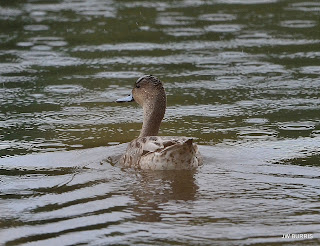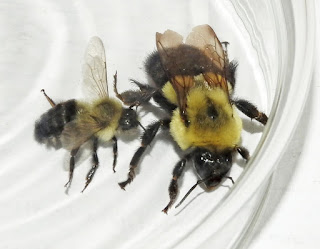**Jean-Paul
and Stella LeBlanc had a WHITE-WINGED DOVE [Tourterelle à ailes blanches] drop
by their yard on Friday to join the MOURNING DOVES [Tourterelle triste] and got
some photos. One would have to wonder if this is the same White-winged Dove
Jean-Paul and Stella hosted last winter for a time. The one that visited them
last winter had a noticeable limp. This one does not, so if it’s the same bird
some healing has taken place. Stella also comments she saw three EASTERN
BLUEBIRDS [Merlebleu de l'Est] on Thursday.
**Georges
Brun observes the drain-down of Jones Lake due to the construction on the Main
Street control gates has attracted an assortment of CANADA GEESE [Bernache du
Canada], MALLARD Ducks [Canard colvert], BLACK DUCKS [Canard noir], Gulls
[Goéland], and WOOD DUCKS [Canard branchu] to forage around the rain ponds and
silt. Georges noted four Wood Ducks in the area just east of the fire station on
Milner Road on September 20th.
This temporarily changed habitat could attract some surprises this time of year,
and should be monitored if one is in the area.
**Jamie
Burris caught an AMERICAN GOLDFINCH [Chardonneret jaune] scenario in his yard on
Thursday. The adult was about to feed the fledgling
but
when it didn’t get the seed it impatiently jumped on the adult’s back, knocking
it down. The American Goldfinch is a late-season nester, so young are still
being fed even though
moulting is
evident in the photo. While in Hillsborough on Friday, Jamie noted Gray Brook
Marsh had ten NORTHERN PINTAILS [Canard pilet] enjoying the rainy day. A few
days ago Jamie shared a photo of a BANDED ARGIOPE Spider [nom latin:
Argiope
trifasciata]
encapsulating
prey. We have two common species of Argiope
Spiders
in New Brunswick that are prominent at the moment due to their size and striking
markings. Jamie submits two nice photos from a top view to easily identify the
two Argiope
species.
**Aldo
Dorio came across a Warbler [Paruline] movement on Thursday that included
BLACK-THROATED GREEN [Paruline à gorge noire], BLACKPOLL [Paruline rayée], and
YELLOW-RUMPED WARBLER [Paruline à croupion jaune]. It is that time window of
year that we can see the Blackpoll Warbler in its fall plumage, which is quite
different from its spring plumage. It has a tendency to migrate along the coast,
which is where Aldo saw this one, at Hay Island. Most Blackpoll Warblers nest to
the north of us.
**John
Foster just returned from a 10-day trip to Beijing,
China visiting family. He comments despite the pollution Beijing has lots of
birds, with the COMMON
MAGPIE [Pie bavarde] and the AZURE-WINGED MAGPIE [Pie-bleue à calotte noire]
very common. He shares a photo of a Common Magpie. It seems to have a
similar
plumage to the BLACK-BILLED MAGPIE [Pie d'Amérique] of western North America.
Gilles Belliveau comments he thinks the Eurasian and North American Magpie were
once considered the same species but now are considered separate species. I
don’t recall one visiting New Brunswick, but the western North American bird as
a vagrant would be a welcome Rare Bird Alert.
**Wednesday’s
“Stick Bird” seemed
to bring to mind incidents with other birders. Eileen
Pike adds
a bird to the list: she and
Rose-Alma Mallet
backtracked to identify a “Buoy Bird” in the water off Deer Island. I suspect
every one of us has already had binoculars strained on this species. Louise
Nichols thinks I got the identification wrong. Louise notes the flat head, the
obviously short legs and blunt tail, to identify it as a “Lesser” Stick Bird!
Will rerun that photo today so folks can check on Louise’s comments.
**Attached
is this week’s Sky at a Glance, courtesy of Curt Nason, and you’re seeing it
right: October 1st
is next week. Where did September go?
This Week’s Sky
at a Glance, September 24 – October 1
Salamanders aren’t the most noticeable of critters; you usually have to
make an effort to find one. This is a good time to locate the obscure
constellation of Lacerta the Lizard, but it will take some effort and a
dark sky.
Camouflaged partly by the Milky Way, Lacerta is surrounded by Cepheus,
Cassiopeia, Pegasus and Cygnus. A good pointer to it is the base of the
Summer Triangle. Running a line from bright Vega to Deneb at the tail of
Cygnus and extending it about the same distance puts you near the zigzag
shape of the lizard. It is one of those dim constellations created in
the late 17th century by Hevelius to fill in an “empty” section of the
sky. If you manage to catch it, give yourself a pat on the back and let
it go.
This Week in the Solar System
Saturday’s sunrise in Moncton is at 7:09 am and sunset will occur at
7:12 pm, giving 12 hours, 3 minutes of daylight (7:14 am and 7:17 pm in
Saint John). Next Saturday the Sun will rise at 7:18 am and set at 6:58
pm, giving 11 hours, 40 minutes of daylight (7:23 am and 7:04 pm in
Saint John).
The Moon is at third quarter on Friday, September 23, and the new Moon
occurs next Friday. Mercury is at its best morning viewing for the year,
rising about 90 minutes before the Sun and getting higher and brighter.
A slim crescent Moon might be visible beside it on Thursday morning, and
if you are away from urban skyglow an hour before sunrise look for the
subtle glow of zodiacal light rising through them. Venus is low in the
west in twilight, setting around 8:15 pm. Midweek, see if you can spot a
hazy patch above Mars with binoculars. That is M8, the Lagoon Nebula,
with star cluster NGC 6530 beside it. Saturn continues to look great in
a scope during late twilight, sitting above orange Antares.
The Saint John Astronomy Club meets at the Rockwood Park Interpretation
Centre on October 1 at 7 pm. All are welcome and it is free.
Questions? Contact me at nasonc@nbnet.nb.ca.
Salamanders aren’t the most noticeable of critters; you usually have to
make an effort to find one. This is a good time to locate the obscure
constellation of Lacerta the Lizard, but it will take some effort and a
dark sky.
Camouflaged partly by the Milky Way, Lacerta is surrounded by Cepheus,
Cassiopeia, Pegasus and Cygnus. A good pointer to it is the base of the
Summer Triangle. Running a line from bright Vega to Deneb at the tail of
Cygnus and extending it about the same distance puts you near the zigzag
shape of the lizard. It is one of those dim constellations created in
the late 17th century by Hevelius to fill in an “empty” section of the
sky. If you manage to catch it, give yourself a pat on the back and let
it go.
This Week in the Solar System
Saturday’s sunrise in Moncton is at 7:09 am and sunset will occur at
7:12 pm, giving 12 hours, 3 minutes of daylight (7:14 am and 7:17 pm in
Saint John). Next Saturday the Sun will rise at 7:18 am and set at 6:58
pm, giving 11 hours, 40 minutes of daylight (7:23 am and 7:04 pm in
Saint John).
The Moon is at third quarter on Friday, September 23, and the new Moon
occurs next Friday. Mercury is at its best morning viewing for the year,
rising about 90 minutes before the Sun and getting higher and brighter.
A slim crescent Moon might be visible beside it on Thursday morning, and
if you are away from urban skyglow an hour before sunrise look for the
subtle glow of zodiacal light rising through them. Venus is low in the
west in twilight, setting around 8:15 pm. Midweek, see if you can spot a
hazy patch above Mars with binoculars. That is M8, the Lagoon Nebula,
with star cluster NGC 6530 beside it. Saturn continues to look great in
a scope during late twilight, sitting above orange Antares.
The Saint John Astronomy Club meets at the Rockwood Park Interpretation
Centre on October 1 at 7 pm. All are welcome and it is free.
Questions? Contact me at nasonc@nbnet.nb.ca.
Nelson Poirier
Nature Moncton
AMERICAN GOLDFINCH FEEDING YOUNG.a. SEPT 22 2016 JAMIE BURRIS
AMERICAN GOLDFINCH FEEDING YOUNG.b. SEPT 22 2016 JAMIE BURRIS
AMERICAN GOLDFINCH FEEDING YOUNG.c. SEPT 22 2016 JAMIE BURRIS
BANDED ARGIOPE SPIDER (ARGIOPE TRIFASCIATA) SEPT 21, 2016.JAMIE BURRIS
BLACK AND YELLOW ARGIOPE SPIDER (ARGIOPE AURANTIA) SEPT 21, 2016.JAMIE BURRIS
BLACK-THROATED GREEN WARBLER.SEPT22, 2016.ALDO DORIO.
BLACK-THROATED GREEN WARBLER.SEPT22, 2016.ALDO DORIO.
BLACKPOLL WARBLER.SEPT22, 2016.ALDO DORIO
COMMON MAGPIE IN BEIJING, CHINA.SEPT, 2016.JOHN FOSTER
Lacerta
NORTHERN PINTAIL SEPT 23 2016 JAMIE BURRIS
STICK BIRD.SEPT 21, 2016.NELSON POIRIER
WHITE-WINGED DOVE (FAR LEFT). SEPT 23,2016. JP LEBLANC
WHITE-WINGED DOVE.SEPT 23,2016. JP LEBLANC
WOOD DUCKS SEPT 20 2016 GEORGES BRUN
YELLOW-RUMPED WARBLER.SEPT22, 2016.ALDO DORIO


















































